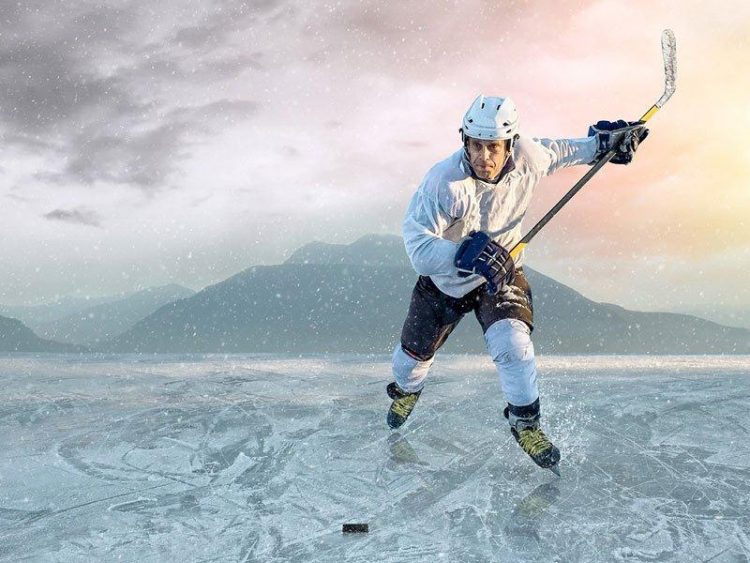By BRIAN SUTTON, MA, MS, CSCS, NASM-CPT, CES, PES
Hockey is arguably the quintessential competitive sport of the cold weather season. Here we’ll discuss the unique demands of ice hockey and how sports performance professionals can safely and effectively implement conditioning programs to maximize an athlete’s performance on the ice. The sports performance professional will focus on two primary objectives; decrease risk of injury and improve “on-ice” performance.
Note: This article will focus on position players within the sport of hockey and not specifically on the goal-tending position. Goalie is a unique position within the sport; however, the same basic fundamentals should be considered when analyzing movement patterns, demand of the position, and enhancing performance.
Demands of the Sport: General Information (1)
- Activity is characterized by high-intensity intermittent skating with rapid changes in velocity and duration.
- Aerobic and anaerobic energy systems are important to cardiorespiratory conditioning.
- Movement is primarily skating forward without the puck; however, movement is rarely linear for more than a couple of strides. This should not be confused with lateral motion; turns can range from gradual to sharp and therefore loading of the legs is seldom equal.
- Change of direction includes stopping, backwards skating, and some lateral movement.
Demand of the Sport: Specific Information (1)
- Duration of game: 60 minutes (3 × 20-minute periods)
- Player on ice (shift): 15–20 minutes, defensemen typically play more minutes than forwards
- Duration of each shift: 30–80 seconds
- Average shift length: 39 seconds
- Recovery between shifts: 3–4 minutes
- Work to rest ratio of 1:2–1:3
- Brief periods of accelerated sprints while on the ice: 4–7 seconds
- Frequent body contact (player to player, player to boards), adding additional stress to body

Off-season Goals and Considerations (1)
The goal of an off-season program should focus on reconditioning the entire kinetic chain and developing a baseline level of fitness (flexibility, stamina, strength, power).
- Physical and mental reconditioning.
- Correcting impaired movement patterns and muscle imbalances based on results of movement screens (and goniometric measurements if applicable).
- Improving range of motion, joint stability, and muscle strength and endurance.
- Improving cardiorespiratory conditioning (aerobic/anaerobic).
- Improving total body stabilization, strength, and power.
- Developing a systematic off-season plan that incorporates integrated training, including core training, balance training, plyometric training, SAQ training, resistance training, and cardiorespiratory training combined with a proper nutrition plan to maximize training and recovery.
- Appropriate rest should be given between workouts and practices to maximize gains and minimize the possibility of overtraining.
- Conditioning programs for hockey should be as similar to the “in-game” demands as possible including exercises in multiple planes of motion and similar ground reaction forces.
- Opt for an undulating periodization scheme versus linear periodization.
Preseason Goals and Considerations (1)
The goal of a pre-season program should focus on injury prevention and maintaining gains incurred during the off-season program while a natural increase in sport-specific activity (e.g., hockey practice) increases.
- Correcting impaired movement patterns based on results of preseason assessments.
- Decrease the chance of injury during participation in practices and games while maintaining physical health and optimal performance within such activities.
- Maintain range of motion, joint stability, and muscle strength and endurance.
- Maintain cardiorespiratory conditioning (anaerobic/aerobic).
- Maintain total body stabilization, strength, and power.
- Apply proper recovery and reconditioning during this time of increased activity.
- Consider the exercise volume of injury prevention and performance training based on the athlete’s increased activity level and adjust accordingly.
- Establish with the athlete an in-season strategy and plan based on what the athlete needs, wants, and will have the capability to do.
In-season Goals and Considerations (1)
The goal of an in-season program should focus on injury prevention and maintaining gains incurred during the off-season program while a natural increase in sport-specific activity (e.g., hockey practice and games) increases. Special considerations must be made to accommodate the athlete’s demanding schedule.
- Perform assessments and testing to ensure program considerations are being made to prevent overuse injuries and maintain performance levels.
- Continued attention to impaired movement patterns with corrective strategies being implemented.
- Maintain range of motion, joint stability, and muscle strength and endurance.
- Maintain cardiorespiratory conditioning (anaerobic/aerobic).
- Maintain total body stabilization, strength, and power.
- Consider additional conditioning for athletes that may not get the same type of on-ice minutes during games as other players.
- Developing a systematic in-season maintenance plan that allows the athlete to minimize decreases in performance and chance of injury over a long season with repetitive sport movement patterns and physical contact.
- Consider the exercise volume of injury prevention and performance training based on the athlete’s increased travel and activity level and adjust accordingly.
- Establish with the athlete a communication process for monitoring the in-season maintenance plan based on what the athlete needs, wants, and will have the capability to do.

Reference:
- Clark, M. Lucett S. (2010). NASM’s Essentials of Sports Performance Training. Philadelphia, PA: Lippincott Williams & Wilkins.

